It lifts its stubby wings and does a few practice flaps as I snap away with my telephoto lens, then it launches forward and it’s off, whirring out across the dark blue expanse of the North Sea in search of food.
Seabird city: getting close to puffins at Flamborough Cliffs
Seabird colony at Flamborough Cliff (C) Rod Jones
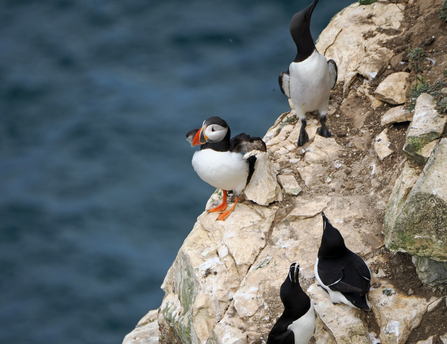
Puffin (C) Rod Jones
Cute, endearing, comical: it’s almost impossible not to love puffins, with their clowns’ faces and black and white cuddly toy bodies. If you want to see them (and why on earth wouldn’t you?), Yorkshire Wildlife Trust’s reserve here at Flamborough Cliffs near Bridlington is one of the best places in Britain – but you’ve only got a few weeks left to do it.
Puffins spend most of the year far out at sea, bobbing around in large groups called rafts. They head for the coast in April to begin nesting, but by mid-July they’ll have raised their chicks, or pufflings, and will be getting ready to disappear to ride the waves for another nine months.
They may be the Yorkshire coast’s most charismatic visitors, but puffins are heavily outnumbered by other species in Flamborough’s seabird city. As I walk up from the car park at North Landing, I can see black dots moving everywhere on the sheer white cliffs that drop 120 metres down to the sea. Through my binoculars, I can work out that most of them are guillemots and razorbills – both, like puffins, members of the auk family.
When I follow the path to the top of the cliffs and look down, I’m astonished by how tightly they’re packed together on vertiginous ledges. Have a look at this photo and try to count how many guillemots are crammed into these few square metres.
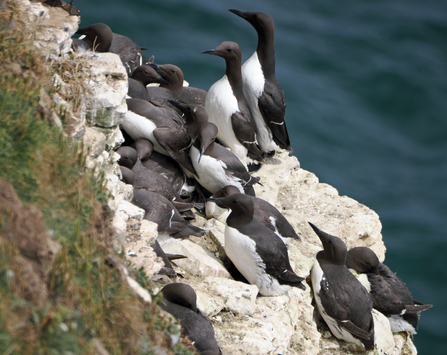
Guillemots (C) Rod Jones
They’re so squashed together, it’s hard to be sure, but I think the answer may be 18. Anyway, it’s easy to see why Flamborough is home to tens of thousands of seabirds in the spring and summer, each trying to raise a family on a tiny, precarious patch of cliff.
The auks have other neighbours living very close by – dots of grey and white on the ledges: kittiwakes, herring gulls and fulmars (which look similar to gulls, but are related to albatrosses).
I watch a group of kittiwakes swooping down and squabbling in the tufty grass at the top of a cliff. They’re strikingly beautiful gulls, with snow-white plumage, pale yellow bills, and black eyes and legs. They’re tugging at clumps of grass, presumably gathering vegetation to line their nests, while making a variety of noises that sound somewhere between a squawk, a purr and a growl.
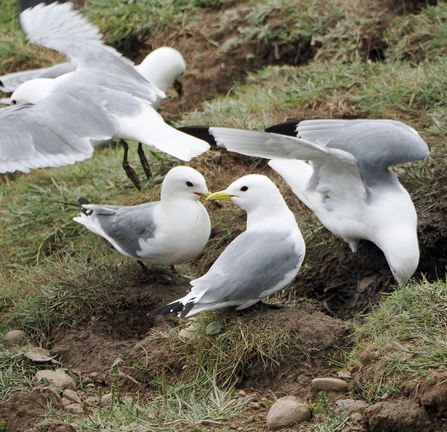
Kittiwakes (C) Rod Jones
The volume is turned up much higher as I walk round a cove near Breil Nook, the most densely-populated district of this seabird city. I’m hit by a great cacophony, as the screeches, squawks and croaks of thousands of birds of various species echo round the rocks.
It’s an experience for another of the senses, too: all these cliff dwellers are bringing back food from the North Sea, and my nose is assailed by a strong smell of oily fish.
There’s such a frenzy of activity, it’s tempting to keep your eyes, binoculars and camera fixed on the cliffs, but there’s plenty going on in the sky as well. Squadrons of gannets – the UK’s largest seabird, with a wingspan of up to two metres – are soaring round the headlands. Some of them are younger birds, whose mottled plumage will gradually become brilliant white as they reach full maturity.
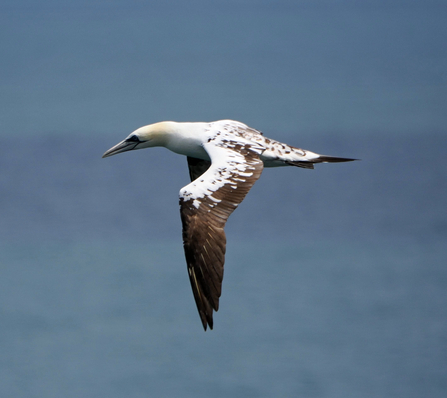
Juvenile gannet (C) Rod Jones
Despite their colourful appearance, the puffins are quieter and harder to spot than some of their more numerous and noisier neighbours. The ones I see are either on their own or in groups of two or three, rather than the massive, raucous gatherings of guillemots and razorbills.
I find one standing photogenically among a patch of yellow flowers on one of the grassy slopes at the top of a cliff. This is where the puffins nest in burrows, so this bird may well have growing pufflings nearby, hidden underground to protect them from predators.
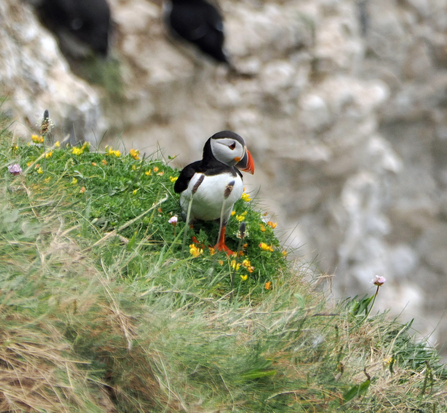
Puffin (C) Rod Jones
I watch as it preens its feathers and stretches its little wings – important preparations, as it needs to be in good shape to fly 20 miles or more out to sea in search of the sand eels it relies on to feed its young. The bad news is that it’s getting harder for puffins to find that food. As the climate crisis causes temperatures in the North Sea to rise, sand eels are being forced further north in search of colder waters.
That means puffins have to fly further away from their nests here on the Yorkshire coast in search of food, leaving their vulnerable chicks on their own for longer. Because of that, each year, fewer pufflings fledge, and puffins are now red-listed as an endangered species.
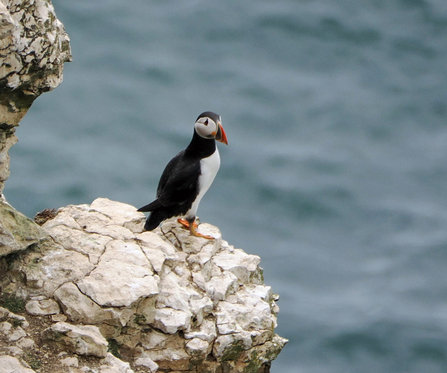
Puffin (C) Rod Jones
These appealing clifftop characters desperately need our help: if we act now to reverse the environmental crisis, we can make sure they recover and thrive.
That would give future generations the chance to enjoy the sort of magical day’s puffin-watching that I’ve just experienced on this spectacular piece of Yorkshire coastline.
*The Yorkshire Puffin Festival gives you the chance to get close to these charismatic seabirds. Join us at Flamborough on Saturday 7th and Sunday 8th June for expert-led guided walks, boat trips and much more.
For more details, go to: https://www.ywt.org.uk/yorkshire-puffin-festival

